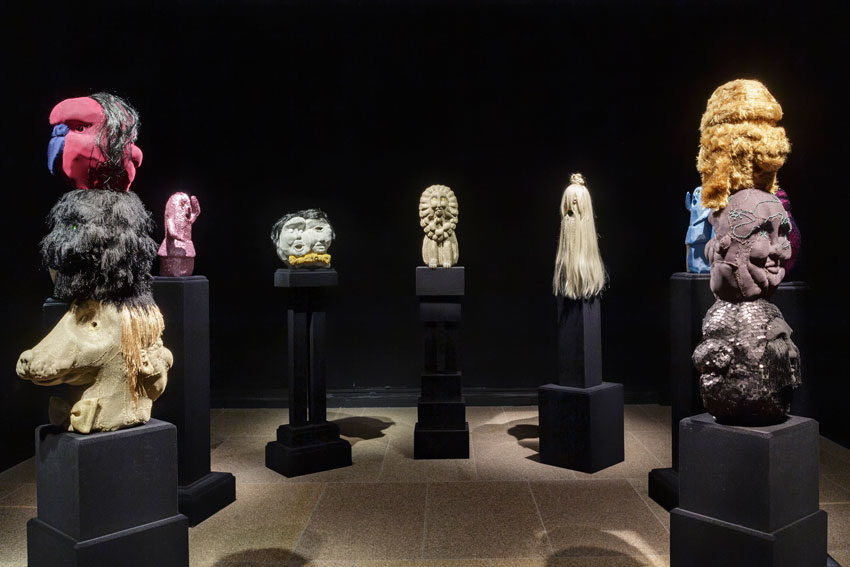A Thread Runs Through It: Soft sculpture seers, sentinels, and soldiers

The colourful textile characters of Tarryn Gill’s Guardians finds themselves in conversation with a series of earlier installations at the Art Gallery of South Australia.
There was an artistic revolution during the 20th century that led to the emergence of fibre arts in the 1970s, propelled in large part by the second feminist movement. Innovators of this new fibre art genre created conceptually-based textiles, experimented with materials and techniques, and exploited three-dimensionality and scale. The result was a merging of textiles, sculpture and installation art.
Despite these exciting developments, associations between textiles, domesticity and women’s work continued to dominate popular perceptions of textiles. Fibre artists faced persistent challenges in having their work accepted as fine art and displayed in commercial or public galleries. It has been heartening therefore to see some major pieces of conceptually based fibre arts featured in exhibitions at the Art Gallery of South Australia (AGSA) over the past four years, several of which are now in the permanent collection.
I mused on this after seeing Tarryn Gill’s Guardians (2015) installation at AGSA recently. Gill completed a series of sound-emitting soft sculptures following a residency at the Freud Museum in London.
She was inspired in part by the studio of psychoanalyst Anna Freud, who apparently would sit and knit or weave on her loom while analysing her patients. The stitched fabric figures emitted sounds like humming, chattering or chanting; at times they seemed to be muttering to themselves, at others conversing with each other, and finally harmonising. Many had a familiar look, with imagery drawn from the collection of Greek, Roman, Egyptian and Asian art and antiquities that belonged to Sigmund Freud – Anna’s father – still on display in the Freud Museum. Others were inspired by characters found in pop culture, such as Chewbacca from Star Wars. Gill has referred to them as seers or prophets and, displayed on plinths in a circle, they were reminiscent of haniwa, Japanese clay tomb ornaments arranged around a burial site to drive away evil and protect the dead.

This theatrical presentation and soundscape reminded me of another dramatic installation: Heather B. Swann’s Banksia Men, displayed as part of Magic Object, the 2016 Adelaide Biennial of Australian Art. Eight tall, dark and rather sinister anthropomorphic figures, made from coarse black sisal bodies with glittering glass eyes, were displayed in a darkened room like a sinister, sentinel army, with a haunting and evocative soundtrack of commissioned music from composer Thomas Green and words from poet Kevin Brophy. Later in the year, the Banksia Men – actually wearable sculptures – were presented at the National Gallery of Australia and were brought to life with live music and voice in world premiere performances of Nervous. The music was performed by Astrid Connelly and Jack Swann, two young classically trained singers, by members of the Leichhardt Espresso Chorus Ristretto, and by contemporary chamber music ensembles Continuum Sax and Plexus.
Another memorable artwork made using fabrics and other media, is Fiona Hall’s installation All the King’s Men, displayed at AGSA in Sappers & Shrapnel: Contemporary Art and the Art of the Trenches a couple of years ago. Hall used the unmistakable khaki green or camouflage fabric of military uniforms to create an installation that was a powerful commentary on the futility of war. It comprised 18 suspended ‘figures’ dangling in a row, illuminated by spotlights that cast ghostly shadows onto the wall. Made from flimsy tatters of uniforms with merely a suggestion of torsos and limbs, the distorted forms hinted at violent death and were both corporeal and ethereal.

Atop these figures were ghastly, distorted heads with gaping mouths, swellings and cavities, made of knitted fibres and a variety of found objects, such as animal horns, bones and teeth. In some, glass ‘eyes’ glinted as the figures gently turned in currents of air, while in one, a single billiard ball looked like a large cyclopic eyeball, pointedly numbered 13. Military insignia, such as a metal badge, embroidered flag patch, or epaulettes with stripes, chevrons and stars, were still attached to the scraps of uniforms, the glints of metal and patches of colour providing subtle clues to the many nationalities united by death in this sad procession.
These fibre artworks challenge conventional perceptions of textiles as warm, comfortable and pretty, instead evoking feelings of discomfort and fear, and associations with insanity, spirits and death. The emotive subject matter and dramatic atmospherics of their presentation provide strong images which will persist in my memory. The use of fibre arts for powerful and emotionally charged works such as these and their presentation and acquisition in a major art gallery such as AGSA, demonstrate that textiles is now recognised as a serious art form within contemporary Australian art.